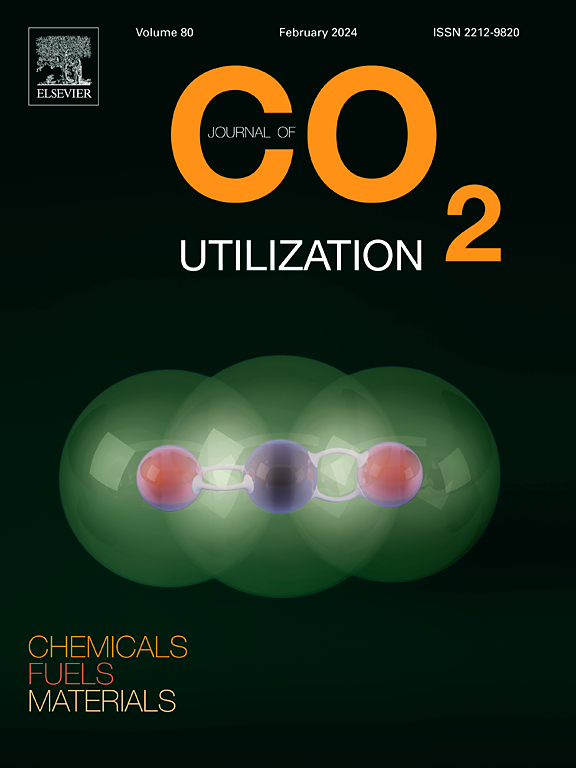枝状纳米二氧化硅上离子液体负载的Lu2CrMnO6催化烟气中丙胺与CO2的转化
IF 8.4
2区 工程技术
Q1 CHEMISTRY, MULTIDISCIPLINARY
引用次数: 0
摘要
相界面和线状结构的并发创建可以增强树突状二氧化硅纤维(DFNS)的分离,酶效率和功能。尽管如此,一种简单而环保的制造方法仍然是必不可少的。在这项研究中,我们成功地开发了一种复杂的类似蒲公英的SiO2,具有锐钛矿/SiO2相界面和高度不同的表面积,使用简单且环保的深共晶溶剂调制技术。其广泛而独特的表面积归因于其三维分层结构,由具有介观空腔的二维超薄纳米层组成。我们通过简单的合成路线合成了离子液体负载在DFNS (Lu2CrMnO6@IL-DFNS)上的Lu2CrMnO6纳米颗粒。DFNS提供了大量的-OH基团,通过化学连接均匀地装载IL,而IL调节纤维尺寸并暴露-NH2基团的动态吸附位点,促进CO2的化学吸附。Lu2CrMnO6@IL-DFNS复合材料的聚集体形态在Lu2CrMnO6@IL加载后基本保持不变,保持其介孔结构、晶体形态和化学吸附性能。由于该催化剂的明显表面积有限,活性位点较少,在丙炔胺和CO2直接合成2-恶唑烷酮的过程中,其生成率较低。本文章由计算机程序翻译,如有差异,请以英文原文为准。
Conversion of propargylic amines with CO2 from flue gas using Lu2CrMnO6 supported by ionic liquid on dendritic nanosilica
The concurrent creation of a phase interface and threadlike architecture can enhance the segregation, enzymatic efficiency, and functionality of dendritic silica fibres (DFNS). Nonetheless, a straightforward and eco-friendly fabrication method remains essential. In this study, we successfully developed a sophisticated dandelion-resembling SiO2 with an anatase/SiO2 phase interface and highly distinct surface area using a simple and environmentally benign deep eutectic solvent-modulating technique. The extensive distinct surface area is attributed to its 3D hierarchical structure, composed of 2D ultrathin nanolayers with mesoscopic cavities. We synthesized Lu2CrMnO6 nanoparticles with ionic liquid loaded on DFNS (Lu2CrMnO6@IL-DFNS) through an uncomplicated synthetic route. DFNS provided numerous -OH groups for uniform IL loading via chemical linkage, while IL adjusted the fibre dimensions and exposed dynamic adsorption sites of –NH2 groups, facilitating CO2 chemisorption. The aggregate morphology of the Lu2CrMnO6@IL-DFNS composite remained largely unchanged after Lu2CrMnO6@IL loading, maintaining its mesoporous structure, crystalline form, and chemisorptive properties. This catalyst exhibited a low incidence of 2-oxazolidinone generation during the direct synthesis from propargylic amines and CO2 owing to its limited distinct surface area and fewer active sites.
求助全文
通过发布文献求助,成功后即可免费获取论文全文。
去求助
来源期刊

Journal of CO2 Utilization
CHEMISTRY, MULTIDISCIPLINARY-ENGINEERING, CHEMICAL
CiteScore
13.90
自引率
10.40%
发文量
406
审稿时长
2.8 months
期刊介绍:
The Journal of CO2 Utilization offers a single, multi-disciplinary, scholarly platform for the exchange of novel research in the field of CO2 re-use for scientists and engineers in chemicals, fuels and materials.
The emphasis is on the dissemination of leading-edge research from basic science to the development of new processes, technologies and applications.
The Journal of CO2 Utilization publishes original peer-reviewed research papers, reviews, and short communications, including experimental and theoretical work, and analytical models and simulations.
 求助内容:
求助内容: 应助结果提醒方式:
应助结果提醒方式:


